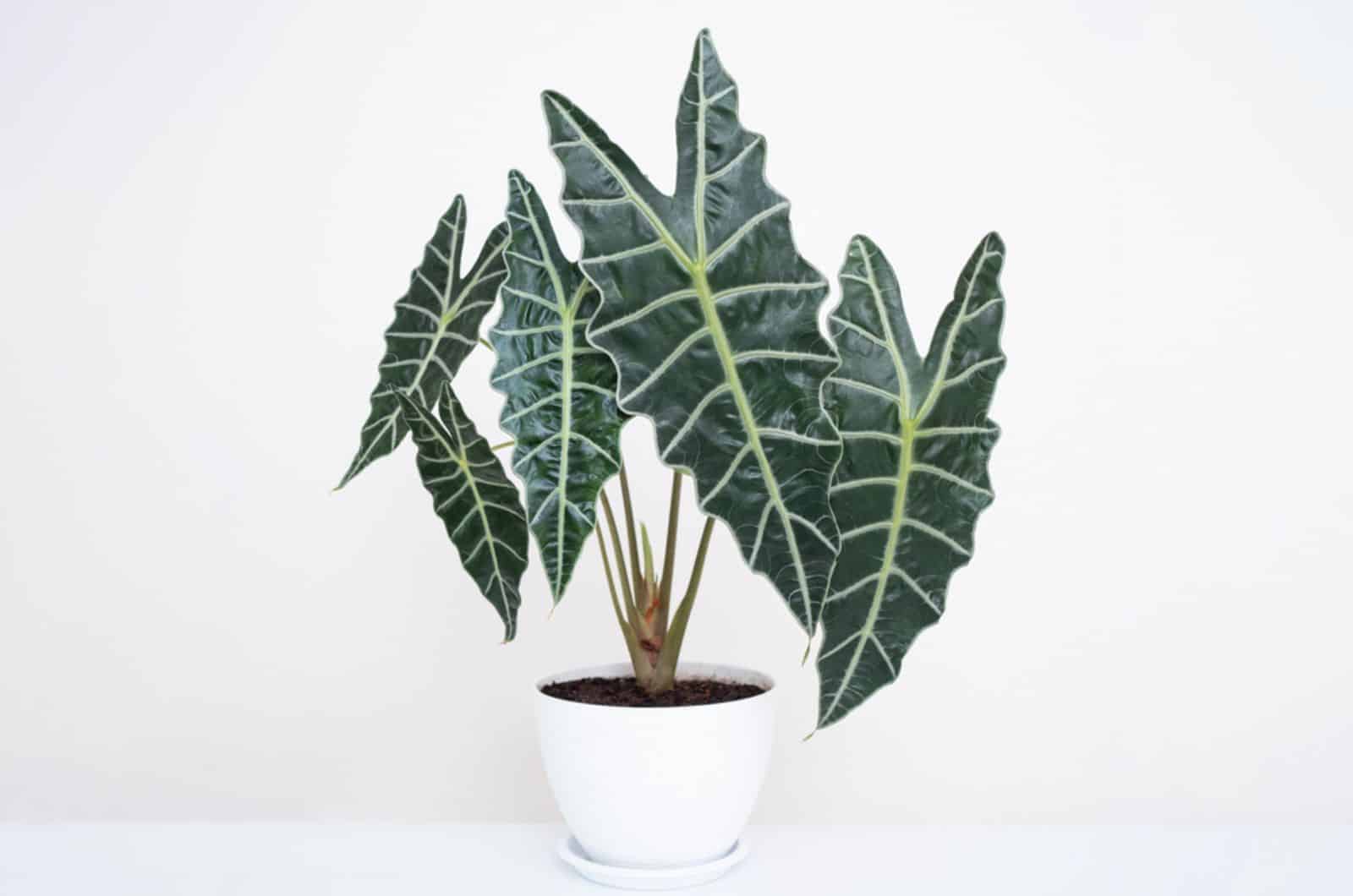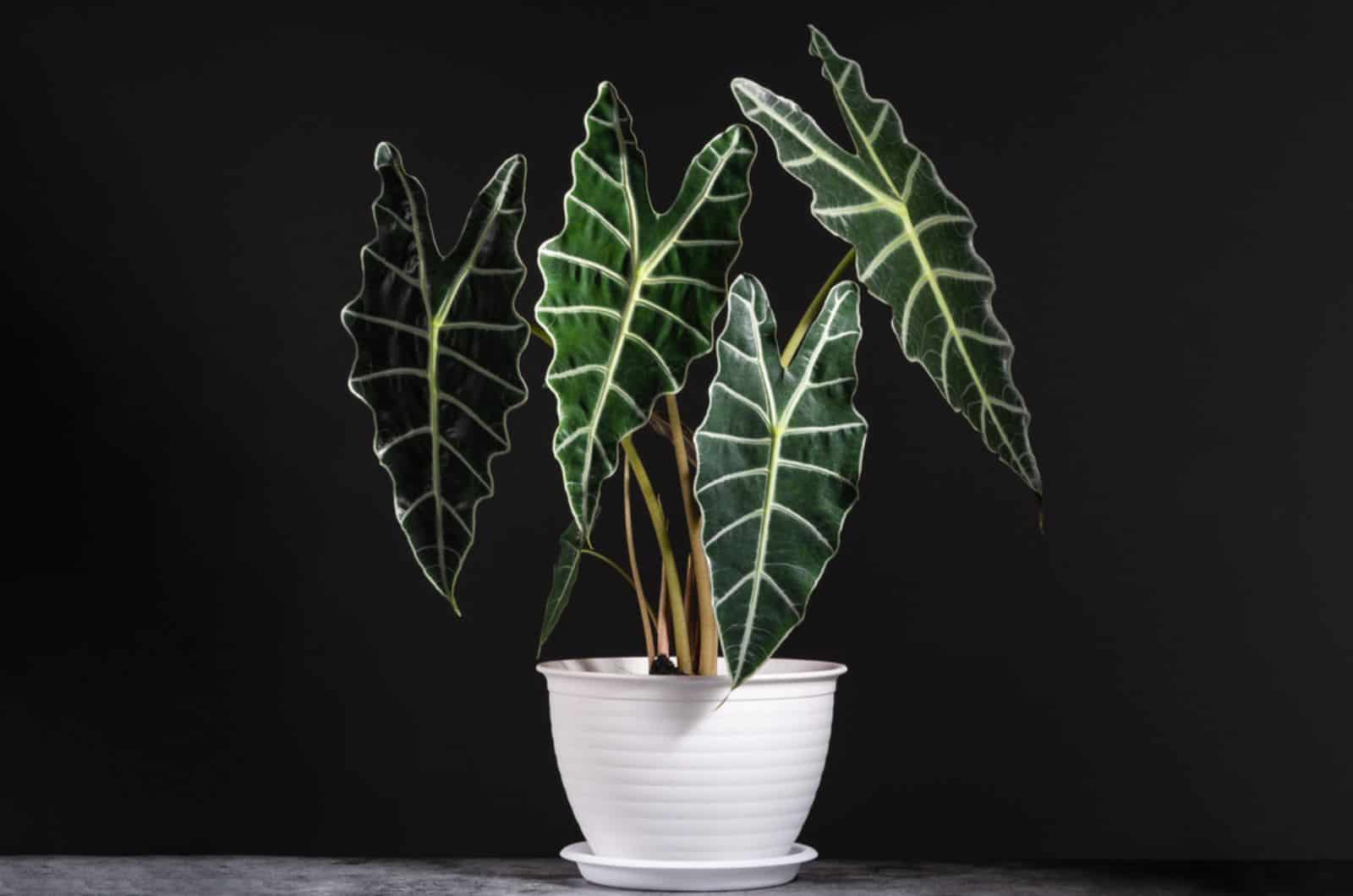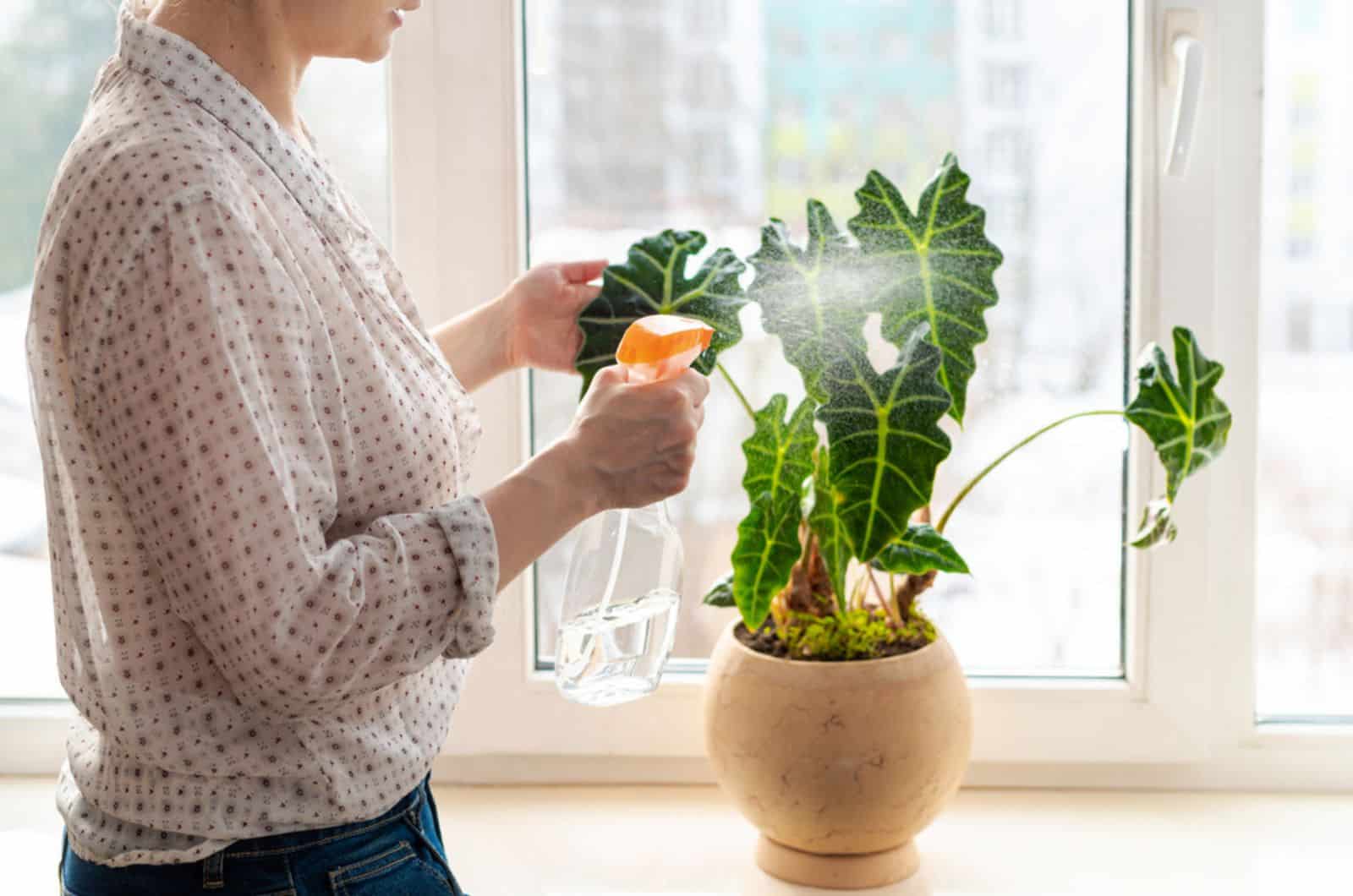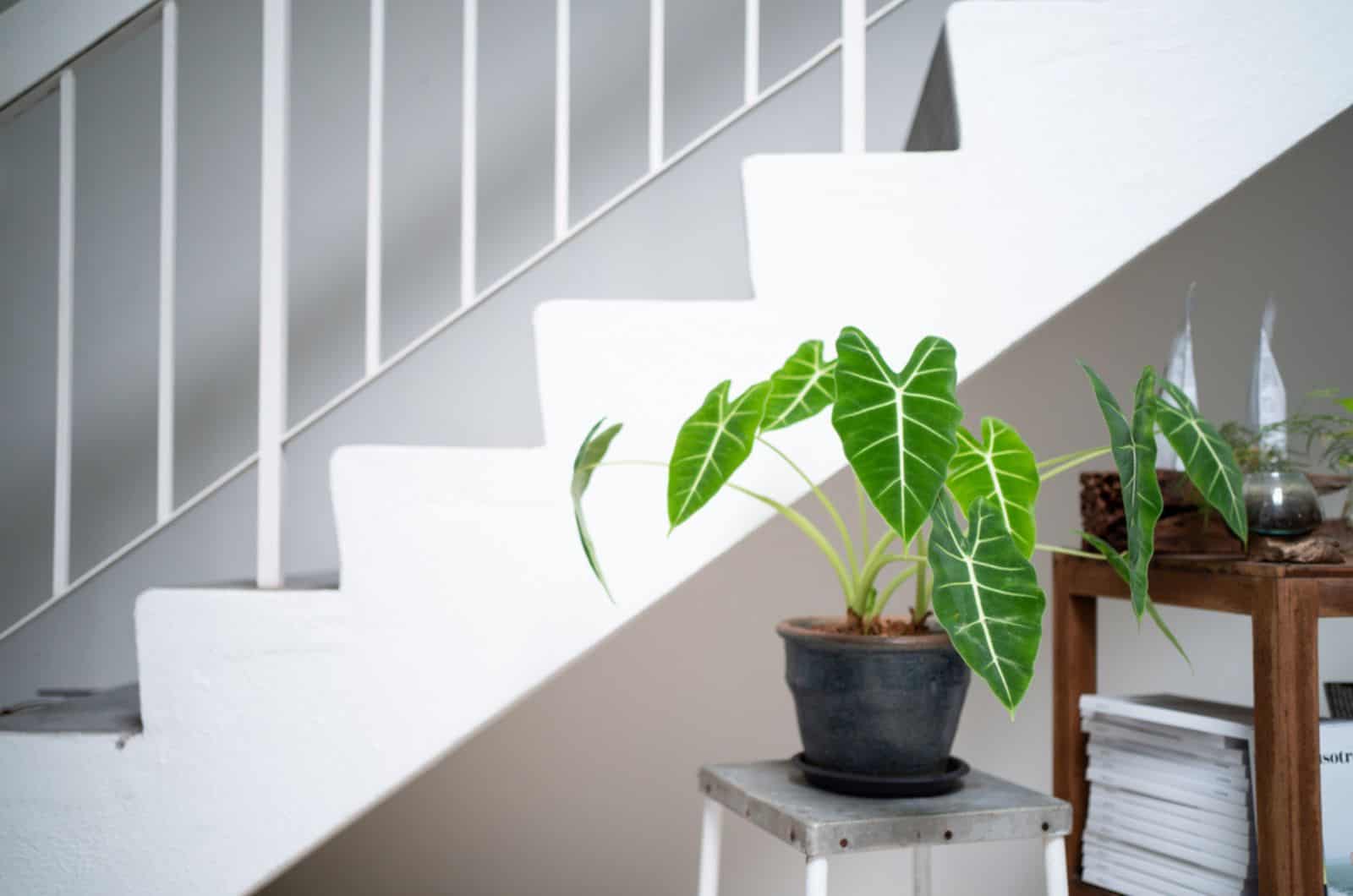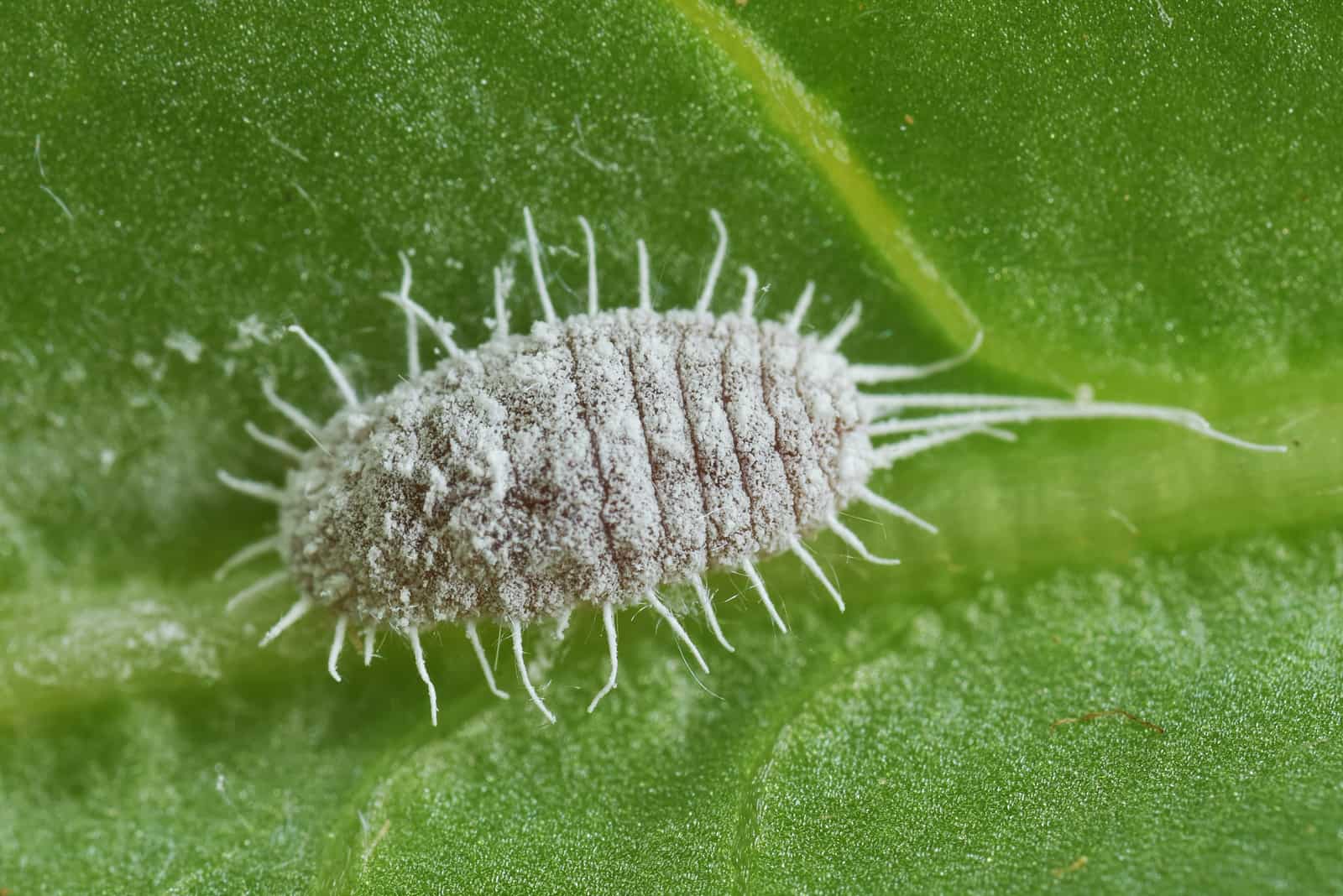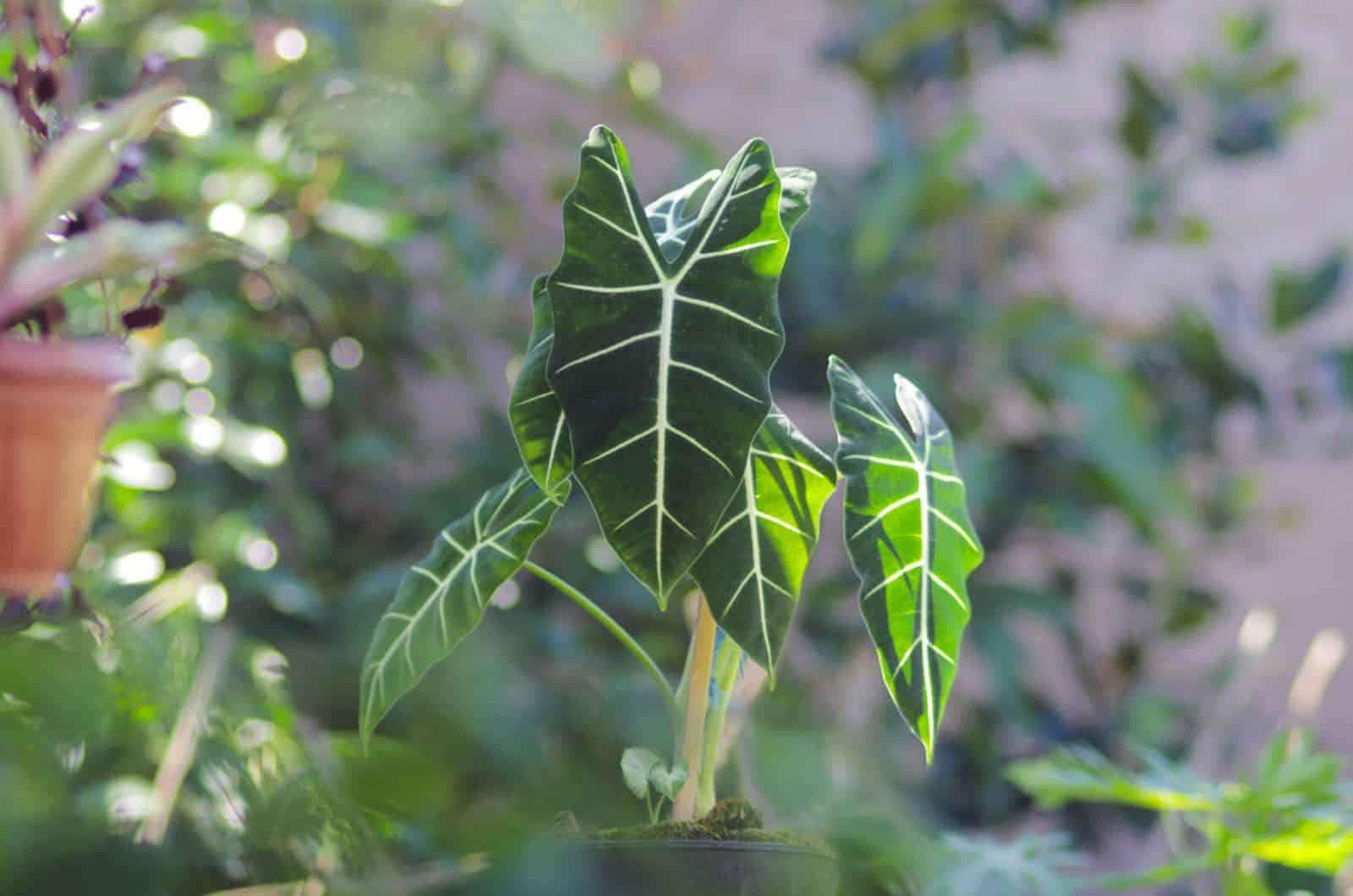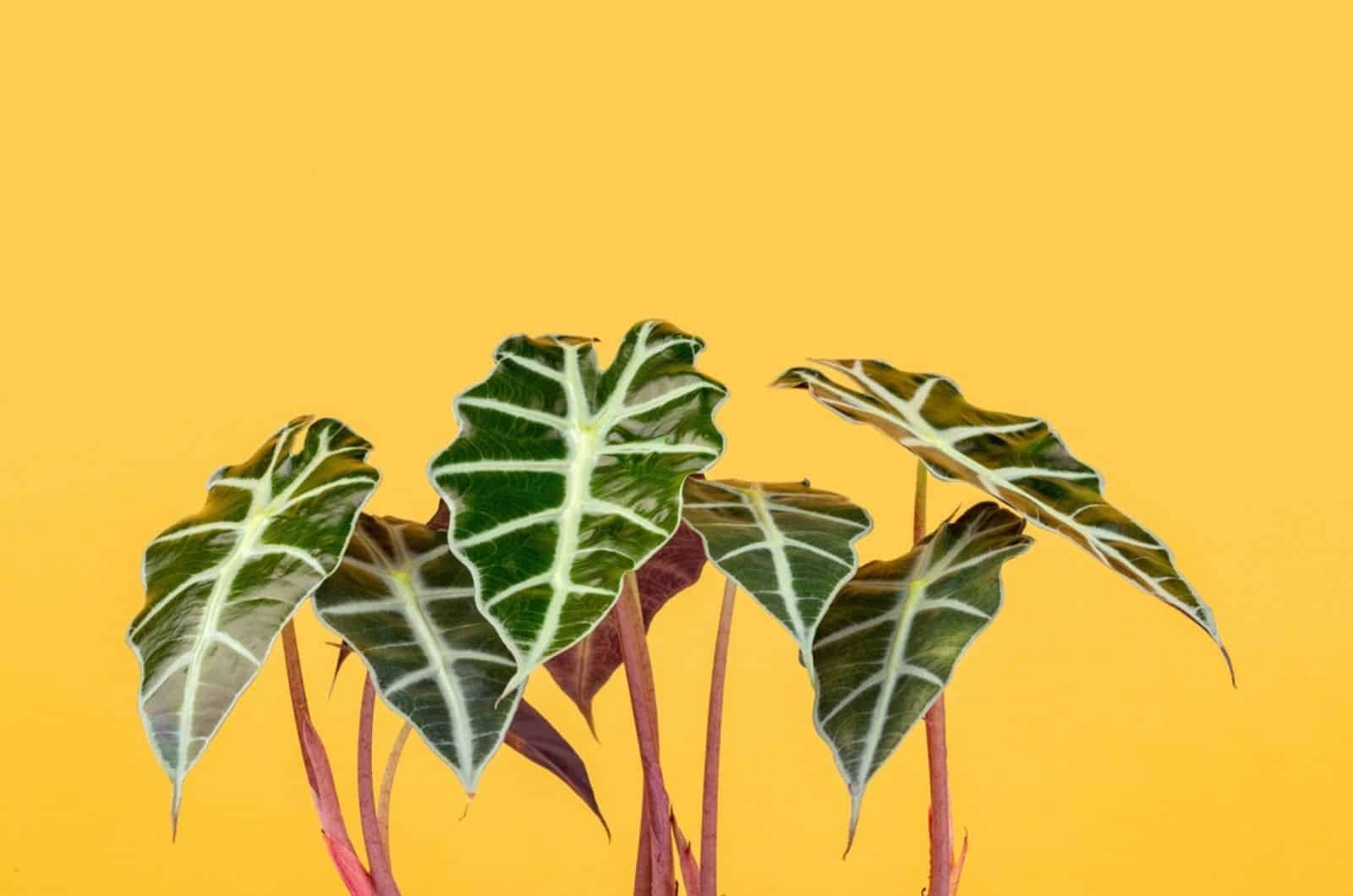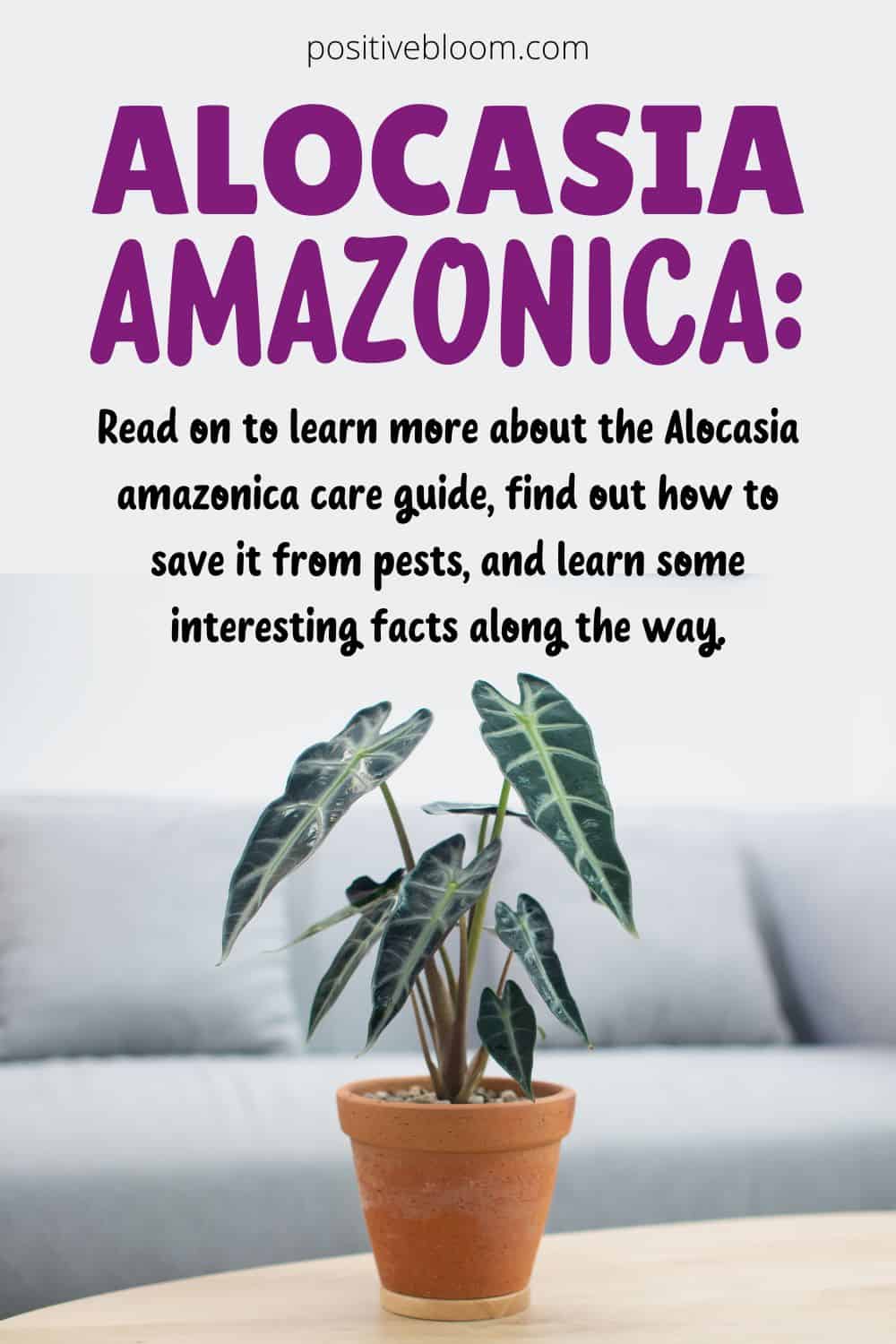The Alocasia amazonica is an excellent plant for beginners because it is easy to care for and adds a lot to indoor gardens.
However, “easy-to-care-for” can be a little misleading, so we need to get into more detail about specific plant care.
This article examines the plant care guide for the Alocasia Amazonica in great detail and will teach you everything you need to know in order to keep this plant healthy.
I know that many plant lovers, myself included, want to discover everything they can about the plants they own, which is why I included some interesting facts about this plant at the end of the article!
Before we move on, let’s look into the basic characteristics of this plant:
[table id=311 /]Alocasia Amazonica Plant Care
The needs of jewel alocasia varieties are virtually the same as those of this alocasia plant, which is why many gardeners grow them side by side.
But even though this aroid is not demanding, there are still some things you need to look out for in order to have it grow strong.
This Amazonian is a tropical plant, which means it cannot tolerate too much direct sun, needs a moist and well-draining growing medium, and high humidity levels.
However, there are some other things you need to know related to Elephant ear plant care, such as when and how to repot and propagate them, how to clean and prune them, and how to deter and deal with the pests and diseases that afflict them.
We’ll discuss all these issues, as well as some care tips to keep your plant happy and healthy.
Let’s dive right in!
Light Requirements
This houseplant prefers bright indirect light, so you should keep it in a spot where direct sunlight won’t burn its green foliage.
However, that doesn’t mean you should keep it in complete darkness! It can become leggy, its leaves will fade, and its growth will slow down or stop completely if it doesn’t get enough light.
All plants need enough light to photosynthesize and produce the resources required for further growth and development, but if you keep them in low-light conditions, they won’t be able to engage in the process of photosynthesis.
Therefore, you should keep this plant near east, west, or south-facing windows for the best results. However, don’t place them on the west or south-facing windowsills, as you’ll risk sunburns.
Instead, keep them a few feet away from bright windows, and your plant will thrive.
Furthermore, you can always invest in some artificial lights for plants if your apartment is north-facing or you don’t have more room in all the well-lit spaces.
Water And Humidity
Watering your plants properly is essential for their health. However, people tend to overwater their plants when they see the word “tropical” in their names.
Tropical plants don’t need to be drowned in water to be healthy! On the contrary, too much water around their root systems will eventually lead to root rot.
Too much water can lead to another phenomenon, so don’t be surprised if you notice that your elephant ear plant is dripping water! Drops may appear on your plant’s leaves due to too much moisture in the soil (or air), so ensure you irrigate your plant only when it needs it.
It is not difficult to determine when your plant needs more water; simply put your finger in the soil, and if the top 2-3 inches are dry, you can water this Amazonian (you can also use a moisture meter for this).
Generally speaking, you might need to irrigate this alocasia once or twice a week during the plant’s growing season and 2-4 times a month once it enters dormancy.
Bear in mind that you will need to water your alocasia more if the weather is hot and there isn’t enough air moisture around your plant.
High humidity is central to the proper development and appearance of this plant, and we’ll talk more about it in the following paragraphs.
Humidity
Like most aroids, this variety also requires high humidity – anything between 70-90% is ideal.
Unfortunately, most of our homes aren’t that humid (lucky for us), so we need to find some creative ways of increasing air moisture around our humidity-loving plants.
Some methods work better than others, but we’ll still examine them so you can decide which one is best for your plant and climate.
Humidifier
If you live in an arid region and want to grow alocasia plants, you will definitely need one of these machines! Humidifiers are the best way to increase air moisture around your plant in dry climates (and probably the only way).
They can significantly raise humidity levels and keep your plant healthy at all times.
Pebble Tray Method
Using pebble trays to increase humidity is a controversial subject, and no one seems to agree on whether they actually work or not.
It is important to note that gravel trays can raise the air moisture around some smaller plants, so they could work for a small plant such as Alocasia amazonica.
The increase in humidity is quite insignificant (a maximum of 7% in the summer), which is not enough if you live in a dry region.
But, if you live in a more humid area and want to give your plants a little bit of an extra boost, you can assemble the pebble tray and place your plant on it. You simply need to find a tray, fill it with water and gravel, and that’s it!
Terrarium
Putting this alocasia in a terrarium is an excellent alternative to pebble trays as they trap moisture and keep your plant hydrated.
This Amazonian is fairly small, so it can fit in certain glass containers. All you have to do is place a growing mix in the vessel, put your plant in it, water it lightly, and mist the leaves occasionally.
Grouping Plants
Gathering your plants all in one place might seem like an excellent way to preserve some of the moisture they transpire.
However, the increase in humidity won’t be significant, especially if you live in an arid climate, which is why you should combine this method with another one, such as misting.
You can even group your plants in more humid rooms of your home, such as kitchens or bathrooms; just ensure there is enough light and mist them from time to time if the hygrometer shows that air moisture is below 70%.
Spraying Plants
Occasionally misting your plants is an excellent way of increasing the air moisture around them; it is simple, effective, and costs you nothing (well, almost nothing – you still have to invest in a sprayer and water).
However, it’s easy to overdo it with spraying and create problems for our plants, like fungal diseases. Leaf spot and powdery mildew can quickly develop in hot and humid conditions, and if your plant’s leaves are constantly moist, fungi are bound to appear.
This problem is easily avoided; simply let your alocasia leaves dry completely between misting, and your plant will be fungus-free.
Temperature
Alocasia amazonica care is straightforward, but it doesn’t mean you can keep it at any temperature you want.
This plant can live in USDA hardiness zones 10-12, which indicates that it cannot survive the freezing winters and cold weather in general.
The preferred temperatures for this plant are 65-80°F, and anything below 60°F may trigger dormancy.
Lower temperatures can lead to cold shock, which may lead to irreversible issues if you don’t move your plant to a warmer spot.
You should also avoid places where sudden temperature drops are likely to occur, such as drafty windows, high-traffic areas (doorways, hallways), AC vents, heaters, etc.
These areas also tend to lower humidity levels, so you’ll be facing two problems instead of one.
Soil And Fertilizer
This indoor plant doesn’t require much, but custom-made potting mixes are essential. I don’t mean that you have to make a special mix for each plant, but there are ready-made mixes for aroids, succulents, etc., and you can use them instead of regular potting soil.
The best blend for alocasia plants contains both well-draining and moisture-retentive elements, so your plant won’t drown in water, nor will it need irrigation every day.
Therefore, you should combine materials such as potting soil, peat moss, or coco coir, which retain moisture, with materials that increase drainage, such as perlite, orchid bark, pumice, etc.
If you want to reduce the time you spend taking care of your plants, consider researching the pros and cons of using LECA for plants.
You’ll just have to place your plant in a glass container, add some (hydrated) LECA clay balls, and fill the vessel with water.
The clay pebbles will absorb some moisture, and after you add some hydroponics fertilizer, your plants will have all the nutrients they need. They won’t even suffer from root rot as they’ll develop water roots that can survive in such systems.
Fertilizer
Even if you plant your green friend in the perfect substrate, you will still have to feed it from time to time to speed up its growth and replenish the nutrients in the soil.
However, there are a couple of general rules you should follow for foolproof fertilization that won’t harm your plant.
First, it is vital to feed your plant only during the growing season. Fertilizing plants during dormancy doesn’t yield any results and will likely burn your plant because it cannot use the additional minerals you feed it with.
Furthermore, you should fertilize this plant once or twice a month to avoid overfertilization.
You also have to be careful about the type of fertilizer you use. You can’t just feed this plant with any old fertilizer you get your hands on because it might not contain all the nutrients this alocasia needs (or it might contain too much of them).
It’s best to use houseplant fertilizers diluted to half-strength in order to avoid fertilizer burns.
Finally, don’t forget to water your plants before or immediately after feeding them, as it will make the minerals available for absorption.
Repotting
This plant grows fast, which means you will have to repot it once a year or more if it doubles in size before one year passes.
One of the main benefits of repotting is fresh soil, which brings more nutrients your plant can use and prevents the salt build-up that may occur after fertilization.
Another plus is that your plant’s roots get more room, so they can expand, and your plant can continue growing.
However, there are some things you should know before repotting your Amazonian.
The number one rule of replanting is doing it during the plant’s growing season (preferably in spring) because it can get used to the soil and recover from the transplant shock.
The weather in spring is also cooler, so you won’t have to worry about the water evaporating too quickly from the growing medium due to high temperatures.
Furthermore, if your plant has grown, choose a container one or two pot sizes larger than the previous one and make sure it has drainage holes.
Ensure that your plant is well hydrated before repotting it, and water it thoroughly after replanting. Allow the excess moisture to drain away through the potholes.
Here are some more tips on repotting this alocasia:
Propagation
If you want new plants to spread around your house or to give as gifts, you can always propagate your alocasia.
The Alocasia amazonica is propagated using offsets from the mother plant, and the best time to divide these plants is during their growing season. You can even combine propagation with repotting and reduce the amount of work you have to do.
Below you’ll find our guide to propagating this alocasia plant:
Step 1. Take the plant out of its container and gently loosen the soil around the roots to make the division easier.
Step 2. Find the offset and its roots. Try to get as many roots as possible and then carefully pull them away from the parent plant. If you cannot easily divide the offset from the mother plant, you can use some sharp and sterilized sheers to cut the parts still attached to the parent plant.
Step 3. Plant the offset in a pot with drainage holes. Fill it with a well-draining potting mix and water until the growing medium is evenly moist.
Step 4. Place the new alocasia in a spot with bright indirect light, ensure that the soil is consistently moist, and increase the humidity by misting or using a humidifier.
You will soon notice new growth, and once the plant grows a bit more, you can transplant it into a slightly larger container.
Cleaning And Pruning
The giant alocasia leaves are the main reason people decide to grow this plant, but they have one downside – they attract a lot of dust.
Dusty leaves have never been attractive, and nor will they ever be, so you should clean them whenever you notice any.
Cleaning plant leaves is not rocket science, simply wipe them with a damp cloth.
However, if you want to take the cleaning to another level, you can always dissolve a drop or two of dish soap in water, spray the leaves with the solution, and then wipe them with a damp cloth.
Pruning
You should not be afraid of giving your plants a good pruning as it can make them grow faster, control their size, and help them preserve more energy.
For instance, removing diseased, old, discolored, and dead leaves will create more room for new growth and prevent your plant from wasting energy on the parts that are no longer viable.
As this plant doesn’t get that tall, you won’t have to trim it to control its size very often. And if it’s still too large for your taste, you can always snip off some leaves – just make sure you never prune more than 1/3 of the entire plant.
You also need to ensure that your pruning shears are always sharp because dull blades can tear your plant and cause damage, which makes it difficult for the plant to uptake water.
Furthermore, always sterilize the tools you use for your plants, or they may transfer bacteria or fungi spores to healthy plants.
Finally, there are some excellent pruners for arthritic hands if you lack strength, and the ergonomic handles of these secateurs will make you forget you’re using the shears in the first place!
Pests And Diseases
Unfortunately, this plant is not entirely resistant to pests, and the most common you’ll see attacking it are spider mites, mealybugs, and aphids.
Plants weakened through inadequate care are more likely to suffer from pest infestations, so you should do your best to prevent them from visiting your alocasia in the first place.
However, if you do notice any on your plants, you should pick them off or use a cotton swab and rubbing alcohol to remove them.
Larger infestations require the use of horticultural oils or pesticides, so research these products and find the one that best suits you and your plant’s needs.
Diseases
Even though the Alocasia amazonica is fairly disease-resistant, it can still suffer from root rot, leaf spot, powdery mildew, etc.
Root rot is caused by overwatering, and you can recognize it by the yellowing of the leaves, a droopy plant appearance, stunted growth, etc.
If you suspect your plant might be suffering from this disease, you should take it out of its pot, examine the roots, and remove all mushy, soggy, and dark roots you find.
Afterward, you can treat the rest of the roots with a fungicide and repot your plant in a new container filled with fresh soil.
Leaf spot and powdery mildew appear in hot and humid conditions, so you should avoid constantly wetting the plant’s leaves.
The first thing you need to do if you notice lesions or white residue on your plant’s leaves is move it away from your other plants to prevent the disease from spreading. Then, remove the diseased leaves and treat the rest of the plant with a fungicide.
(Sometimes, the leaf spot can be caused by bacteria, so make sure to check what caused it before applying fungicide or bactericide.)
More About The Alocasia Amazonica
In the sections below, you will learn more about this alocasia’s origin, main features, and toxicity.
Let’s begin!
History And Origin
Even though alocasias come from tropical rainforests, this variety is slightly different. It doesn’t come from Southeast Asia or the Amazon, but from Florida!
In fact, this is not even a species, but a hybrid of Alocasia longiloba (also known as Alocasia watsoniana Hort) and Alocasia sanderiana.
But if it’s not from the Amazon, why is it called “amazonica”?
Well, it was discovered that a certain nursery owner, Salvadore Mauro, had named this plant after his nursery (which was called Amazon nursery in 1950, but is closed now).
In fact, not even the parents of this hybrid are Amazonian, but of Southern Asian descent. However, that didn’t stop growers from using the name Alocasia amazonica for more than 60 years after its discovery (or rather cultivation).
The story doesn’t end there. The name has been borrowed to denote some other hybrids and has only been slightly changed in some cases.
This hybrid is also mistakenly known as alocasia x amazonica, but this isn’t a valid scientific name.
Some common names of this plant are jewel alocasia, African mask plant, and alocasia alligator. It is also known as alocasia Polly or even Alocasia amazonica ‘Polly’ in commerce.
Main Features
One of the main questions I get about alocasias in general, is, “What is the difference between alocasia and colocasia?”.
Well, alocasias have distinctive veins on the undersides of their leaves, which are also more pointy than the colocasia leaves.
In fact, the main reason we choose this alocasia to decorate our homes are its deep green leaves. The leathery texture of the arrow-pointed foliage accentuates the silvery white veins that streak the surface of each leaf.
Did you know that this plant can also produce flowers?
Although the plant rarely blooms inside, it can still produce blossoms. However, they are quite insignificant, and their greenish-yellowish spathe doesn’t make them any more attractive.
Toxicity
Unfortunately, the gorgeous leaves and stems of this plant are considered poisonous because they contain calcium oxalate crystals, which can cause skin irritations, a burning sensation, vomiting, excessive drooling, difficulty swallowing, loss of appetite, etc.
Keep your children and pets away from this plant or put it somewhere out of reach, such as a high shelf.
The sap of this plant also contains calcium oxalate crystals, so you should always wear gloves when pruning, propagating, or repotting it.
Common Questions
There is still so much more to learn about this plant!
We managed to narrow it down to the following subjects based on your most common questions.
So, let’s see what you wanted to know.
Is the Alocasia amazonica rare?
No, the Alocasia amazonica is not rare, and you can get it online for about $30. However, you can never be sure which parents the hybrid actually comes from due to the widespread behavior of giving this name to different hybrids.
But that doesn’t mean you shouldn’t get one, as it isn’t that demanding and has the requirements of an alocasia ‘Black Velvet’ you probably already possess or are thinking of getting.
Can the Alocasia amazonica be grown outside?
This plant can only be grown outside in climates that don’t get frost, so don’t plant it in the ground if your region gets chilly winters.
However, there is nothing wrong with keeping your plants indoors; they really beautify the interior!
To Sum Up
And so we come to the end of our article, and you can now nurture your Alocasia amazonica and raise it into a healthy plant.
We included some basic guidelines, such as how much light and water it needs, what type of soil you should plant it in, how to fertilize it, and what the best relative humidity for this plant is.
We also included some tips on repotting, propagation, cleaning, and pruning, as well as some things you can do when your plant is suffering from certain diseases or a pest infestation.
We also discussed some interesting facts about this plant, so now you know it is not a species but a hybrid! We also went through its main features.
Enjoy this excellent addition to your indoor garden, and until next time!
Like this post? Share or pin it for later!

